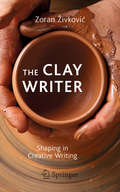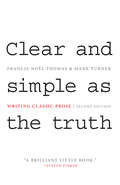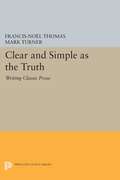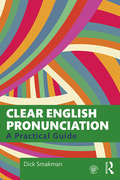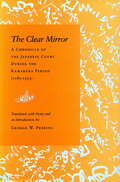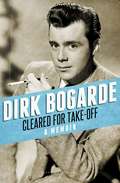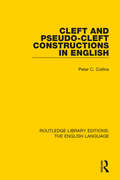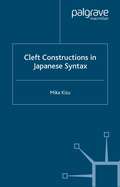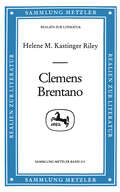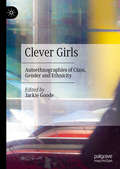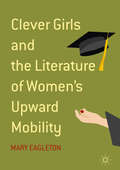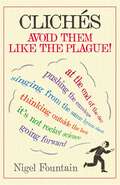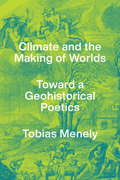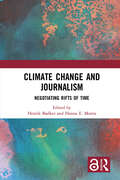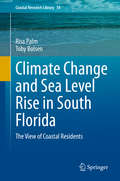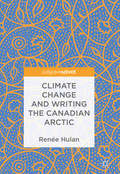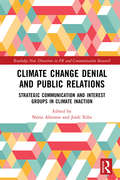- Table View
- List View
The Clay Writer: Shaping in Creative Writing
by Zoran ŽivkovićThis concise book by the well-known Serbian writer and literary researcher summarizes his decade-long experience of teaching creative writing at the Faculty of Philology, University of Belgrade. Always offering attendees four good reasons for not attending his course, or, in a broader perspective, discouraging them from professional writing altogether, the author reflects ultimately on what it really takes to become a writer of literary fiction. This essay, which makes up the first part of this work, is complemented by a selection of witty short stories, forming the second part, and which have been used as templates in the teaching context.
Clear and Simple as the Truth: Writing Classic Prose, Second Edition
by Francis-Noël Thomas Mark TurnerFor more than a decade, Clear and Simple as the Truth has guided readers to consider style not as an elegant accessory of effective prose but as its very heart. Francis-Noël Thomas and Mark Turner present writing as an intellectual activity, not a passive application of verbal skills. In classic style, the motive is truth, the purpose is presentation, the reader and writer are intellectual equals, and the occasion is informal. This general style of presentation is at home everywhere, from business memos to personal letters and from magazine articles to student essays. Everyone talks about style, but no one explains it. The authors of this book do; and in doing so, they provoke the reader to consider style, not as an elegant accessory of effective prose, but as its very heart. At a time when writing skills have virtually disappeared, what can be done? If only people learned the principles of verbal correctness, the essential rules, wouldn't good prose simply fall into place? Thomas and Turner say no. Attending to rules of grammar, sense, and sentence structure will no more lead to effective prose than knowing the mechanics of a golf swing will lead to a hole-in-one. Furthermore, ten-step programs to better writing exacerbate the problem by failing to recognize, as Thomas and Turner point out, that there are many styles with different standards. The book is divided into four parts. The first, "Principles of Classic Style," defines the style and contrasts it with a number of others. "The Museum" is a guided tour through examples of writing, both exquisite and execrable. "The Studio," new to this edition, presents a series of structured exercises. Finally, "Further Readings in Classic Prose" offers a list of additional examples drawn from a range of times, places, and subjects. A companion website, classicprose.com, offers supplementary examples, exhibits, and commentary, and features a selection of pieces written by students in courses that used Clear and Simple as the Truth as a textbook.
Clear and Simple as the Truth: Writing Classic Prose, Second Edition (PDF)
by Francis-Noël Thomas Mark TurnerFor more than a decade, Clear and Simple as the Truth has guided readers to consider style not as an elegant accessory of effective prose but as its very heart. Francis-Noël Thomas and Mark Turner present writing as an intellectual activity, not a passive application of verbal skills. In classic style, the motive is truth, the purpose is presentation, the reader and writer are intellectual equals, and the occasion is informal. This general style of presentation is at home everywhere, from business memos to personal letters and from magazine articles to student essays. Everyone talks about style, but no one explains it. The authors of this book do; and in doing so, they provoke the reader to consider style, not as an elegant accessory of effective prose, but as its very heart. At a time when writing skills have virtually disappeared, what can be done? If only people learned the principles of verbal correctness, the essential rules, wouldn't good prose simply fall into place? Thomas and Turner say no. Attending to rules of grammar, sense, and sentence structure will no more lead to effective prose than knowing the mechanics of a golf swing will lead to a hole-in-one. Furthermore, ten-step programs to better writing exacerbate the problem by failing to recognize, as Thomas and Turner point out, that there are many styles with different standards. The book is divided into four parts. The first, "Principles of Classic Style," defines the style and contrasts it with a number of others. "The Museum" is a guided tour through examples of writing, both exquisite and execrable. "The Studio," new to this edition, presents a series of structured exercises. Finally, "Further Readings in Classic Prose" offers a list of additional examples drawn from a range of times, places, and subjects. A companion website, classicprose.com, offers supplementary examples, exhibits, and commentary, and features a selection of pieces written by students in courses that used Clear and Simple as the Truth as a textbook.
Clear and Simple as the Truth: Writing Classic Prose (PDF)
by Francis-Noël Thomas Mark TurnerEveryone talks about style, but no one explains it. The authors of this book do; and in doing so, they provoke the reader to consider style, not as an elegant accessory of effective prose, but as its very heart.At a time when writing skills have virtually disappeared, what can be done? If only people learned the principles of verbal correctness, the essential rules, wouldn't good prose simply fall into place? Thomas and Turner say no. Attending to rules of grammar, sense, and sentence structure will no more lead to effective prose than knowing the mechanics of a golf swing will lead to a hole-in-one. Furthermore, ten-step programs to better writing exacerbate the problem by failing to recognize, as Thomas and Turner point out, that there are many styles with different standards.In the first half of Clear and Simple, the authors introduce a range of styles--reflexive, practical, plain, contemplative, romantic, prophetic, and others--contrasting them to classic style. Its principles are simple: The writer adopts the pose that the motive is truth, the purpose is presentation, the reader is an intellectual equal, and the occasion is informal. Classic style is at home in everything from business memos to personal letters, from magazine articles to university writing.The second half of the book is a tour of examples--the exquisite and the execrable--showing what has worked and what hasn't. Classic prose is found everywhere: from Thomas Jefferson to Junichirō Tanizaki, from Mark Twain to the observations of an undergraduate. Here are many fine performances in classic style, each clear and simple as the truth.Originally published in 1994.The Princeton Legacy Library uses the latest print-on-demand technology to again make available previously out-of-print books from the distinguished backlist of Princeton University Press. These editions preserve the original texts of these important books while presenting them in durable paperback and hardcover editions. The goal of the Princeton Legacy Library is to vastly increase access to the rich scholarly heritage found in the thousands of books published by Princeton University Press since its founding in 1905.
Clear English Pronunciation: A Practical Guide
by Dick SmakmanClear English Pronunciation provides students with the tools to effectively communicate in English without centring solely on native-speaker pronunciation models. The focus of the book is on individual pronunciation targets rather than a one-size-fits-all approach. Divided into four sections, each featuring detailed articulatory explanations, sample sentences, and recordings to help learners improve their pronunciation, this book: introduces the phenomenon of pronunciation as part of a broader communicative realm; explains and demonstrates the melody and rhythm of understandable and natural English pronunciation; supports students in identifying and practicing their own pronunciation issues. Supported by an interactive companion website which features recordings and expanded explanations of key topics, Clear English Pronunciation is an essential textbook for international learners of English who want to improve their pronunciation skills in diverse social settings. https://www.universiteitleiden.nl/clearenglishpronunciation
Clear English Pronunciation: A Practical Guide
by Dick SmakmanClear English Pronunciation provides students with the tools to effectively communicate in English without centring solely on native-speaker pronunciation models. The focus of the book is on individual pronunciation targets rather than a one-size-fits-all approach. Divided into four sections, each featuring detailed articulatory explanations, sample sentences, and recordings to help learners improve their pronunciation, this book: introduces the phenomenon of pronunciation as part of a broader communicative realm; explains and demonstrates the melody and rhythm of understandable and natural English pronunciation; supports students in identifying and practicing their own pronunciation issues. Supported by an interactive companion website which features recordings and expanded explanations of key topics, Clear English Pronunciation is an essential textbook for international learners of English who want to improve their pronunciation skills in diverse social settings. https://www.universiteitleiden.nl/clearenglishpronunciation
The Clear Mirror: A Chronicle of the Japanese Court During the Kamakura Period (1185-1333)
by George W. PerkinsThe Clear Mirror (Masukagami) is an account of Japanese history from 1185 to 1333 by an anonymous author, almost certainly a court noble writing around the third quarter of the fourteenth century. During this time, the military government at Kamakura controlled the country, maintaining the emperor with his court at Kyoto as symbolic head of state. Though the imperial court had little real power, it attempted to maintain as much of its former dignity and prestige as it could. The Clear Mirror is at least semi-fictionalized, promoting a picture of a court healthier and more powerful than it really was. Moreover, the work sees the court as guardian of its own traditional arts and lifestyle, and thus provides not only a history of imperial succession and other events but also copious examples of poetic expressions and descriptions of courtly traditions and ceremonies. Because of its attempt to exemplify the best in the courtly prose tradition (it is noted for its imitation of the style of the masterpiece The Tale of Genji), the work has long been valued in Japan as much for its artistic literary contribution as for its historical significance. The present translation makes available to English readers the last significant work belonging to the genre of "historical tales" (rekishi monogatari), another example of which is A Tale of Flowering Fortunes (translated by William and Helen Craig McCullough, Stanford, 1980). The introduction provides a brief summary of the significant historical and political events of the period, together with a discussion of the significance of The Clear Mirror within the "historical tales" tradition, and comments on the literary strengths and weaknesses of the work. A glossary identifies people and places mentioned in the text, and an appendix discusses details concerning the work's authorship, possible dates of initial publication, and other matters relating to the original manuscript.
Cleared For Take-Off: A Memoir
by Dirk BogardeFirst published in 1997, Cleared for Take-Off is the seventh and final volume of Dirk Bogarde's best-selling memoirsDuring his many reconnaissance missions in Europe and the Far East, the young Bogarde experienced the terror of enemy attack and the horror of its aftermath, together with the intense camaraderie and bitter humour of the battlefield. He also felt, like countless others, a feeling of utter hopelessness at the war's end, when these youthful, but hardened comrades-in-arms were dispersed to find their feet in a traumatised world. Less than a year after demob, Bogarde found himself starring in his third feature film with car, chauffeur and five-storey house in Chester Row. He had somehow 'arrived' in the movies.
Cleft and Pseudo-Cleft Constructions in English (Routledge Library Editions: The English Language)
by Peter C. CollinsFirst published in 1991, this book examines the communicative properties of ‘cleft’ and ‘pseudo-cleft’ constructions in contemporary English. The book argues that these properties cannot be ignored in any attempt to provide an adequate grammatical description of the constructions. Furthermore, they provide a source of explanations for the patterns of stylistic variation displayed by clefts and pseudo-clefts. The book reports findings from a corpus-based study of clefts and pseudo-clefts in modern British English.
Cleft and Pseudo-Cleft Constructions in English (Routledge Library Editions: The English Language)
by Peter C. CollinsFirst published in 1991, this book examines the communicative properties of ‘cleft’ and ‘pseudo-cleft’ constructions in contemporary English. The book argues that these properties cannot be ignored in any attempt to provide an adequate grammatical description of the constructions. Furthermore, they provide a source of explanations for the patterns of stylistic variation displayed by clefts and pseudo-clefts. The book reports findings from a corpus-based study of clefts and pseudo-clefts in modern British English.
Cleft Constructions in Japanese Syntax
by M. KizuCleft constructions occur across languages and are much analyzed in relation to syntax, semantics and pragmatics. Mika Kizu, working in a Principles and Parameters framework, with some consideration of the Minimalist Program, provides the first coherent account of cleft constructions in Japanese. She claims that the construction is analyzed on a par with topic constructions and some types of relative clause. One of the most interesting properties, the syntactic phenomenon of 'connectivity' is closely examined.
Clemens Brentano (Sammlung Metzler)
by Helene M. Kastinger RileyEine Einführung in Brentanos Gesamtwerk.
Clever Girls: Autoethnographies of Class, Gender and Ethnicity
by Jackie GoodeThis collection by three generations of women from predominantly working-class backgrounds explores the production of the classed, gendered and racialized subject with powerful, engaging, funny and moving stories of transitions through family relationships, education, friendships and work. The developments that take place across a life in processes of ‘becoming’ are examined through the fifteen autoethnographies that form the core of the book, set within an elaboration of the social, educational and geo-political developments that constitute the backdrop to contributors’ lives. Clever Girls discusses the status of personal experience as ‘research data’ and the memory work that goes into the making of autoethnography-as-poiesis. The collection illustrates the huge potential of autoethnography as research method, mode of inquiry and creative practice to illuminate the specificities and commonalities of experiences of growing up as ‘clever girls’ and to sound a ‘call to action’ against inequality and discrimination.
Clever Girls and the Literature of Women's Upward Mobility
by Mary EagletonThis book follows the figure of ‘the clever girl’ from the post-war to the present and focuses on the fiction, plays and memoirs of contemporary British women writers. Spurred on by an ethic of meritocracy, the clever girl is now facing austerity and declining social mobility. Though suggesting optimism, a public discourse of ‘opportunity’, ‘aspiration’ and ‘choice’ is often experienced as an anxious and chancy process. In a wide-ranging study, the book explores the struggle to move away from home and traditional notions of femininity; the persistent problems associated with women’s embodiment; the pressures of class and racial divisions; the new subjectivities of the neoliberal era; and the generational conflict underpinning austerity. The book ends with a consideration of feminism’s place as a phantom presence in this history of clever girls. This study will appeal to readers of contemporary women’s writing and to those interested in what has been one of the dominant social narratives of the post-war period from upward to declining mobility.
Clever Girls and the Literature of Women's Upward Mobility
by Mary EagletonThis book follows the figure of ‘the clever girl’ from the post-war to the present and focuses on the fiction, plays and memoirs of contemporary British women writers. Spurred on by an ethic of meritocracy, the clever girl is now facing austerity and declining social mobility. Though suggesting optimism, a public discourse of ‘opportunity’, ‘aspiration’ and ‘choice’ is often experienced as an anxious and chancy process. In a wide-ranging study, the book explores the struggle to move away from home and traditional notions of femininity; the persistent problems associated with women’s embodiment; the pressures of class and racial divisions; the new subjectivities of the neoliberal era; and the generational conflict underpinning austerity. The book ends with a consideration of feminism’s place as a phantom presence in this history of clever girls. This study will appeal to readers of contemporary women’s writing and to those interested in what has been one of the dominant social narratives of the post-war period from upward to declining mobility.
Clichés: Avoid Them Like The Plague
by Nigel FountainAt the end of the day, when it comes to getting your head around clichés, everybody seems to be singing from the same hymn sheet. Clichés have become such a familiar part of the English language and people's everyday speech that many are now trite, meaningless and often quite irritating. This book looks at clichés in their many forms - once useful but overworked catch phrases ('move the goal posts'), worn-out sayings ('all hands on deck'), pointless phrases used to conceal a weak argument ('to be perfectly honest'), technical terms used out of context ('collateral damage'), and many others. It shows where they came from and, with examples from people who ought to know better, why they should be avoided. Entertaining and informative, this collection of clichés really is the best thing since sliced bread . . .
Climate and the Making of Worlds: Toward a Geohistorical Poetics
by Tobias MenelyIn this book, Tobias Menely develops a materialist ecocriticism, tracking the imprint of the planetary across a long literary history of poetic rewritings and critical readings which continually engage with the climate as a condition of human world making. Menely’s central archive is English poetry written between John Milton’s Paradise Lost (1667) and Charlotte Smith’s “Beachy Head” (1807)—a momentous century and a half during which Britain, emerging from a crisis intensified by the Little Ice Age, established the largest empire in world history and instigated the Industrial Revolution. Incorporating new sciences into ancient literary genres, these ambitious poems aspired to encompass what the eighteenth-century author James Thomson called the “system . . . entire.” Thus they offer a unique record of geohistory, Britain’s epochal transition from an agrarian society, buffeted by climate shocks, to a modern coal-powered nation. Climate and the Making of Worlds is a bracing and sophisticated contribution to ecocriticism, the energy humanities, and the prehistory of the Anthropocene.
Climate and the Making of Worlds: Toward a Geohistorical Poetics
by Tobias MenelyIn this book, Tobias Menely develops a materialist ecocriticism, tracking the imprint of the planetary across a long literary history of poetic rewritings and critical readings which continually engage with the climate as a condition of human world making. Menely’s central archive is English poetry written between John Milton’s Paradise Lost (1667) and Charlotte Smith’s “Beachy Head” (1807)—a momentous century and a half during which Britain, emerging from a crisis intensified by the Little Ice Age, established the largest empire in world history and instigated the Industrial Revolution. Incorporating new sciences into ancient literary genres, these ambitious poems aspired to encompass what the eighteenth-century author James Thomson called the “system . . . entire.” Thus they offer a unique record of geohistory, Britain’s epochal transition from an agrarian society, buffeted by climate shocks, to a modern coal-powered nation. Climate and the Making of Worlds is a bracing and sophisticated contribution to ecocriticism, the energy humanities, and the prehistory of the Anthropocene.
Climate Change and Journalism: Negotiating Rifts of Time
by Henrik BødkerThis edited collection addresses climate change journalism from the perspective of temporality, showcasing how various time scales—from geology, meteorology, politics, journalism, and lived cultures—interact with journalism around the world. Analyzing the meetings of and schisms between various temporalities as they emerge from reporting on climate change globally, Climate Change and Journalism: Negotiating Rifts of Time asks how climate change as a temporal process gets inscribed within the temporalities of journalism. The overarching question of climate change journalism and its relationship to temporality is considered through the themes of environmental justice and slow violence, editorial interventions, ecological loss, and political and religious contexts, which are in turn explored through a selection of case studies from the US, France, Thailand, Brazil, Australia, Spain, Mexico, Canada, and the UK. This is an insightful resource for students and scholars in the fields of journalism, media studies, environmental communication, and communications generally.
Climate Change and Journalism: Negotiating Rifts of Time
by Henrik Bødker Hanna E. MorrisThis edited collection addresses climate change journalism from the perspective of temporality, showcasing how various time scales—from geology, meteorology, politics, journalism, and lived cultures—interact with journalism around the world. Analyzing the meetings of and schisms between various temporalities as they emerge from reporting on climate change globally, Climate Change and Journalism: Negotiating Rifts of Time asks how climate change as a temporal process gets inscribed within the temporalities of journalism. The overarching question of climate change journalism and its relationship to temporality is considered through the themes of environmental justice and slow violence, editorial interventions, ecological loss, and political and religious contexts, which are in turn explored through a selection of case studies from the US, France, Thailand, Brazil, Australia, Spain, Mexico, Canada, and the UK. This is an insightful resource for students and scholars in the fields of journalism, media studies, environmental communication, and communications generally.
Climate Change and Sea Level Rise in South Florida: The View of Coastal Residents (Coastal Research Library #34)
by Risa Palm Toby BolsenSouth Florida is frequently cited as the part of the United State of America as most susceptible to the devastation accompanying sea level rise. Several scholarly studies have shown the negative impact of coastal location in Florida on housing values. Are the residents of South Florida concerned? Is susceptibility to sea level rise actually affecting the housing market in terms of demand, the availability of home mortgages, or house prices? Are people living at particular risk from sea level rise aware of this risk and more open to new information about climate change? Do they support policies and laws to mitigate the pace and extent of climate change? Answers to these questions are not only of general interest, but they are also key to our understanding of the human dimensions of this problem. This book describes the results of a detailed survey in which respondents viewed a local map displaying flooding to their own community that would result from a Category 3 hurricane in 2033. It discusses political party identification and ideology that has an overwhelming impact in shaping views about sea level rise and climate change. This book has enormous implications for the effectiveness of communicating risk information. The text is important if we, as a nation, are to design communication strategies that will lead to broader policy to combat or mitigate this risk.
Climate Change and Writing the Canadian Arctic
by Renée HulanClimate Change and Writing the Canadian Arctic explores the impact of climate change on Canadian literary culture. Analysis of the changing rhetoric surrounding the discovery of the lost ships of the Franklin expedition serves to highlight the political and economic interests that have historically motivated Canada’s approach to the Arctic and shaped literary representations. A recent shift in Canadian writing away from national sovereignty to circumpolar stewardship is revealed in detailed close readings of Kathleen Winter’s Boundless and Sheila Watt-Cloutier’s The Right to Be Cold.
Climate Change and Writing the Canadian Arctic
by Renée HulanClimate Change and Writing the Canadian Arctic explores the impact of climate change on Canadian literary culture. Analysis of the changing rhetoric surrounding the discovery of the lost ships of the Franklin expedition serves to highlight the political and economic interests that have historically motivated Canada’s approach to the Arctic and shaped literary representations. A recent shift in Canadian writing away from national sovereignty to circumpolar stewardship is revealed in detailed close readings of Kathleen Winter’s Boundless and Sheila Watt-Cloutier’s The Right to Be Cold.
Climate Change Denial and Public Relations: Strategic communication and interest groups in climate inaction (Routledge New Directions in PR & Communication Research)
by Núria Almiron Jordi XifraThis is the first book on climate change denial and lobbying that combines the ideology of denial and the role of anthropocentrism in the study of interest groups and communication strategy. Climate Change Denial and Public Relations: Strategic Communication and Interest Groups in Climate Inaction is a critical approach to climate change denial from a strategic communication perspective. The book aims to provide an in-depth analysis of how strategic communication by interest groups is contributing to climate change inaction. It does this from a multidisciplinary perspective that expands the usual approach of climate change denialism and introduces a critical reflection on the roots of the problem, including the ethics of the denialist ideology and the rhetoric and role of climate change advocacy. Topics addressed include the power of persuasive narratives and discourses constructed to support climate inaction by lobbies and think tanks, the dominant human supremacist view and the patriarchal roots of denialists and advocates of climate change alike, the knowledge coalitions of the climate think tank networks, the denial strategies related to climate change of the nuclear, oil, and agrifood lobbies, the role of public relations firms, the anthropocentric roots of public relations, taboo topics such as human overpopulation and meat-eating, and the technological myth. This unique volume is recommended reading for students and scholars of communication and public relations.
